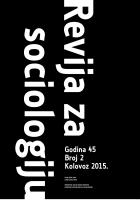Facebook prijatelji kao pokazatelj strukturnih dimenzija društvenog kapitala mladih u Hrvatskoj
Facebook Friends as an Indicator of the Social Capital Structural Dimensions of Youth in Croatia
Author(s): Krešimir KroloSubject(s): Social Sciences, Communication studies, Sociology, Theory of Communication, Social Theory, Management and complex organizations
Published by: Hrvatsko sociološko društvo
Keywords: social capital; youth; digital-interactive media; Facebook friends
Summary/Abstract: The topic of this article is the analysis of the role of the Facebook online social network as a predictor of the social capital structural dimensions of youth in Croatia. The theoretical part of the paper has connected specific dimensions of social capital that stem from the work of Robert D. Putnam with the insights from the research of the new media use among youth. Based on that overview,a methodological framework was constructed containing measures of structural dimensions of offline and online social capital (bonding social capital, bridging social capital, and participation in civic activities), as well as modes and intensity of online social networks use. Data was collected by an online survey in 2012on a convenience sample (N=577) using the snowball method. Data analyses included bivariate and multivariate procedures that were employed to explore the relevance of Facebook friends – together with other characteristics of online social networks use – in accounting for structural dimensions of the social capital of youth in Croatia. Results showed that the number of friends on Facebook is positively associated with online participatory practices of youth as well as with online bridging social capital. That points to two attributes of Facebook friends as an indicator of the social capital of Croatian youth. The first highlights the relationship of civic activism and Facebook as a more flexible form of social engagement compared to classical forms of institutional and organizational engagement(membership in non-governmental organizations). The other emphasizes the role of Facebook as a medium that connects individuals outside their local contextual limitations. Both of those attributes are indicative not only of how communication is being carried out in cyberspace, but also how different forms of social capital are being accumulated in the »digital« society.
Journal: Revija za sociologiju
- Issue Year: 45/2015
- Issue No: 2
- Page Range: 145-170
- Page Count: 26
- Language: Croatian

